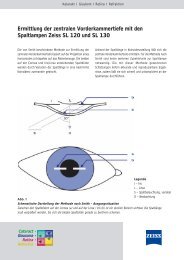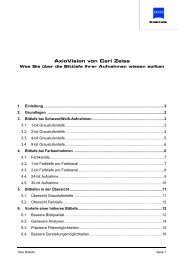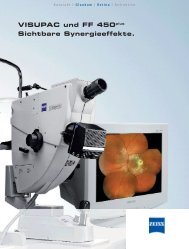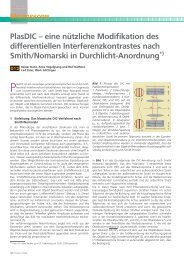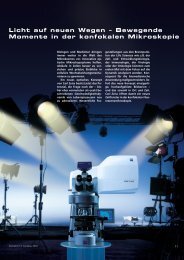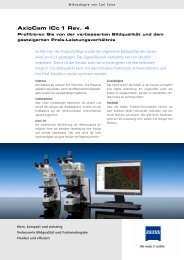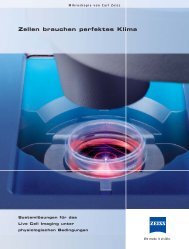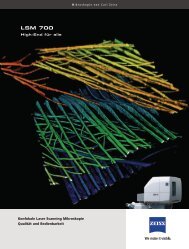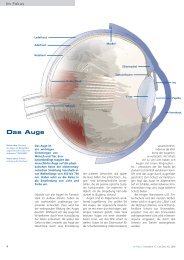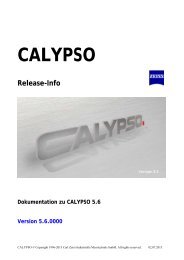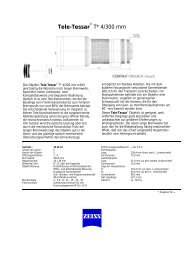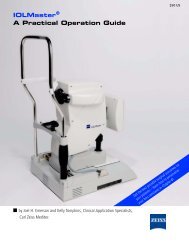FEMTO-LASIK and BEYOND - Carl Zeiss, Inc.
FEMTO-LASIK and BEYOND - Carl Zeiss, Inc.
FEMTO-LASIK and BEYOND - Carl Zeiss, Inc.
Create successful ePaper yourself
Turn your PDF publications into a flip-book with our unique Google optimized e-Paper software.
June 2012 Supplement<br />
5<br />
Figure 1. At 3-month follow-up after ReLEx smile, only a faint<br />
superior incision site is detectable at the slit lamp.<br />
“ReLEx currently has the most advantages for<br />
moderate <strong>and</strong> high myopia when compared<br />
with excimer-based procedures.”<br />
cedure with the 200-kHz laser, but today it is my procedure of<br />
choice with the 500-kHz laser, in particular for moderate <strong>and</strong><br />
high myopia.<br />
Patient comfort: I have found that<br />
patients are more comfortable during<br />
<strong>and</strong> after ReLEx versus femtosecond<br />
<strong>LASIK</strong> <strong>and</strong> surface ablation procedures,<br />
<strong>and</strong> I believe this is because<br />
the cuts made during ReLEx flex, <strong>and</strong><br />
especially ReLEx smile, are smaller<br />
than the surface manipulation with<br />
<strong>LASIK</strong> <strong>and</strong> PRK. Smaller cuts shorten<br />
the time it takes for the epithelium<br />
to heal (Figure 1). While the eye is<br />
healing, patients typically experience<br />
foreign body sensations; with ReLEx<br />
smile procedures, this lasts for no more<br />
than 2 to 3 hours as a minor discomfort<br />
in comparison to approximately 4 to<br />
5 hours with <strong>LASIK</strong> <strong>and</strong> 2 to 3 days<br />
PRK.<br />
During the entire procedure, the patient<br />
feels a little pressure. As shown in a<br />
study by Vetter et al, 1 treatment with the<br />
VisuMax femtosecond laser leads to the<br />
lowest increase in intraocular pressure<br />
as compared with other femtosecond<br />
lasers. Additionally, there is neither any central artery occlusion<br />
(ie, blackout of vision) nor the smell of the fumes typically<br />
created during excimer-based surgery.<br />
Because of the increased stability of the achieved refractive<br />
correction, I can also perform ReLEx in patients with up to<br />
-10.00D of myopia, which otherwise would have received a<br />
phakic IOL. In fact, this week I saw a patient 3 months after<br />
ReLEx smile for -9.50D of myopia. He had an impressive<br />
distance UCVA of 20/12.5 <strong>and</strong> no night driving problems<br />
despite a 6.8-mm scotopic pupil.<br />
<strong>Inc</strong>ision size: The nice thing about ReLEx smile is that there is<br />
no longer a need for the corneal flap. Therefore, this all-in-one<br />
laser procedure reduces the complications associated with the<br />
flap cut, including incomplete or irregular corneal flaps, thin<br />
or small corneal flaps, buttonholes, <strong>and</strong> free caps.<br />
ReLEx smile can be performed using either one or two<br />
incisions. I prefer making two small incisions (3–5 mm) at<br />
the 12- <strong>and</strong> 6-o’clock positions. The use of two incisions<br />
enhances the flow of fluid within the eye when I flush the<br />
interface. These incisions can alternatively be created at the<br />
3- <strong>and</strong> 9-o’clock positions, as is Professor Blum’s technique,<br />
with the same result. Because the opening incisions are only<br />
100 to 120 μm deep, they do not induce astigmatism. When<br />
only one incision is placed, a technique that Rupal Shah, MD,<br />
of India uses, a small pocket is created to extract the lenticule.<br />
ReLEx currently has the most advantages for moderate <strong>and</strong><br />
high myopia when compared with excimer-based procedures.<br />
However, I am participating in a second ongoing study to test<br />
its efficacy for hyperopia. What we do know is that visual<br />
recovery, higher-order aberrations, <strong>and</strong> stability are excellent<br />
for moderate <strong>and</strong> high myopia, as shown in the comparative<br />
studies by Gertnere <strong>and</strong> Hjortdal at a recent <strong>Carl</strong> <strong>Zeiss</strong> users’<br />
meeting held in Dubai. Hyperopia treatment has always been<br />
a more challenging terrain than myopia. However, our first<br />
results on hyperopic ReLEx are encouraging, <strong>and</strong> once we<br />
perfect a cut profile we hope to achieve results similar to<br />
the current excimer st<strong>and</strong>ards.<br />
Conclusion: ReLEx is an exciting new realm in refractive surgery,<br />
<strong>and</strong> any reasonably skilled surgeon can achieve successful<br />
outcomes with this procedure. What I enjoy about ReLEx<br />
is being able to use the same femtosecond laser workplace<br />
for the nonrefractive cut <strong>and</strong> the surgical manipulation itself,<br />
<strong>and</strong> my patients enjoy the faster surgery <strong>and</strong> improved patient<br />
comfort. <br />
1. Vetter JM, Schirra A, Garcia-Bardon D, Lorenz K, Weingärtner WE, Sekundo W.<br />
Comparison of Intraocular Pressure During Corneal Flap Preparation Between a<br />
Femtosecond Laser <strong>and</strong> a Mechanical Microkeratome in Porcine Eyes. Cornea. 2011<br />
Jul 26. [Epub ahead of print.]



